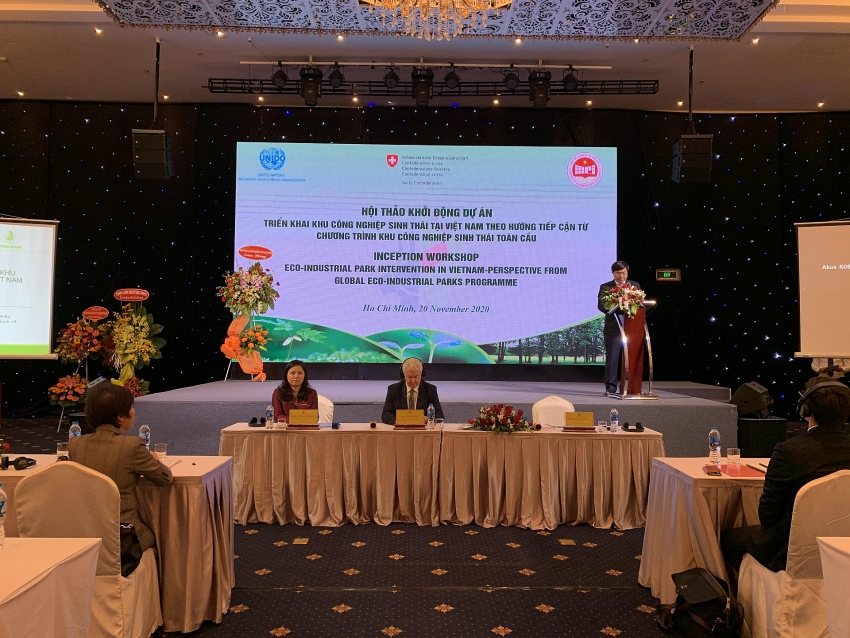Vietnam pushes eco-industrial park intervention
The “Eco-industrial Park Intervention in Vietnam – Perspective from the Global Eco-Industrial Parks Programme” project was launched on November 20 in Ho Chi Minh City by the Ministry of Planning and Investment (MPI) and the United Nations Industrial Development Organisation (UNIDO).
 |
| The eco-industrial park programme was launched by the MPI and UNIDO |
The development of eco-industrial parks (EIP) will make significant contributions to improving the environmental, economic, and social performance of industries in Vietnam and will create a premise to improve policies and regulation about EIP by integrating the EIP model into the legal framework on the environment and industries, as well as relevant policies.
This project has a total budget of more than $1.8 million, in which $1.6 is official development assistance from the Government of Switzerland, through its Swiss State Secretariat for Economic Affairs (SECO), and a co-funding of $138,800 from the MPI. The project will be implemented in Hanoi and five provinces and cities, namely Ho Chi Minh City, Can Tho, Dong Nai, Danang, and Haiphong over the course of 36 months.
Over the past years, industrial parks significantly contributed to the socioeconomic development of Vietnam, however, they are facing a number of environmental challenges.
Therefore, a more sustainable model is needed and it should be in confirmity with the National Strategy for Green Growth and the government’s commitments to achieving the UN Strategic Development Goals by 2030 and the Paris Agreement on Climate Change.
The MPI and UNIDO, with the support of a number of donors, implemented the eco-industrial park initiative in 2014-2019 and gained significant impact on policy development as well as in demonstrating innovative technologies and practices. The EIP model has been mentioned in Decree No.82/2018/ND-CP dated May 22, 2018 of the government on the management of IZs and EZs.
Various solutions for resource-efficient and cleaner production were implemented under the framework of the pilot initiative. They led to an avoided annual demand of over 22,000MWh of electricity, 600,000 cubic metres of freshwater, 140TJ of fossil fuel, and nearly 3,600 tonnes of chemicals and waste, through resource-efficient and cleaner production (RECP) and industrial symbiosis solutions. These solutions also led to an avoided emission of 32 kilotonnes of CO2 every year.
The project is the continuation of the successful implementation of the pilot initiative and, at the same time, will create the foundation for the replication of this model across the country in the coming years.
The project has two components: enhancing policies and instructions for the implementation of EIPs and implementing technical interventions to transform selected industrial parks in EIPs.
It will help improve the legal framework and develop information and technical database to connect businesses and to support the implementation of solutions to transform industrial parks into EIPs.
The EIP model is essential for Vietnam to develop sustainable industrial development while protecting the environment through resource and energy use efficiency.
What the stars mean:
★ Poor ★ ★ Promising ★★★ Good ★★★★ Very good ★★★★★ Exceptional
 Tag:
Tag:
Related Contents
Latest News
More News
- South Korean investors seek clarity on IP lease extensions (November 24, 2025 | 17:48)
- CEO shares insights on Phu My 3 IP’s journey to green industrial growth (November 17, 2025 | 11:53)
- Business leaders give their views on ESG compliance in industrial parks (November 15, 2025 | 09:00)
- Industrial parks pivot to sustainable models amid rising ESG demands (November 14, 2025 | 11:00)
- Amata plans industrial park in Ho Chi Minh City (November 04, 2025 | 15:49)
- Businesses honoured for building a green future at VIPF 2025 (October 30, 2025 | 13:00)
- Vietnam’s growth formula evolves as high-tech and green industries take lead (October 30, 2025 | 08:34)
- Building Vietnam’s green industrial future: materials, mindset, and resource efficiency (October 29, 2025 | 20:00)
- Vietnam navigates complex landscape to accelerate strategic FDI (October 29, 2025 | 19:00)
- SLP charts strategic path through Vietnam’s industrial real estate market (October 29, 2025 | 18:06)

























 Mobile Version
Mobile Version